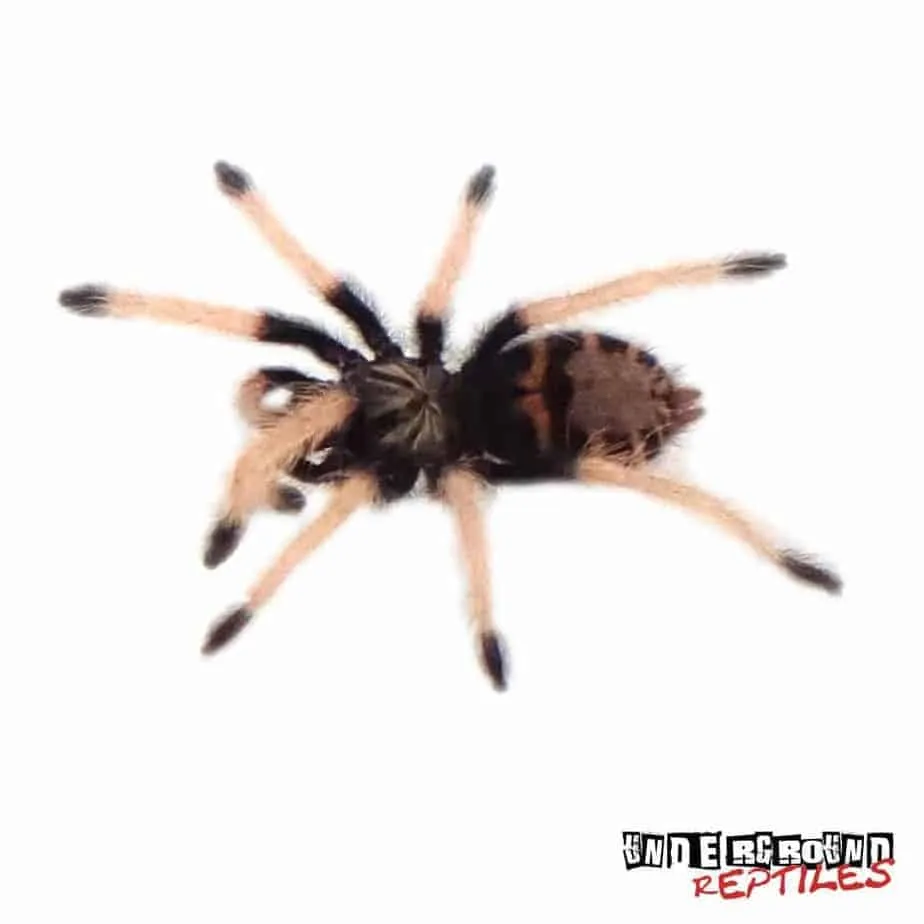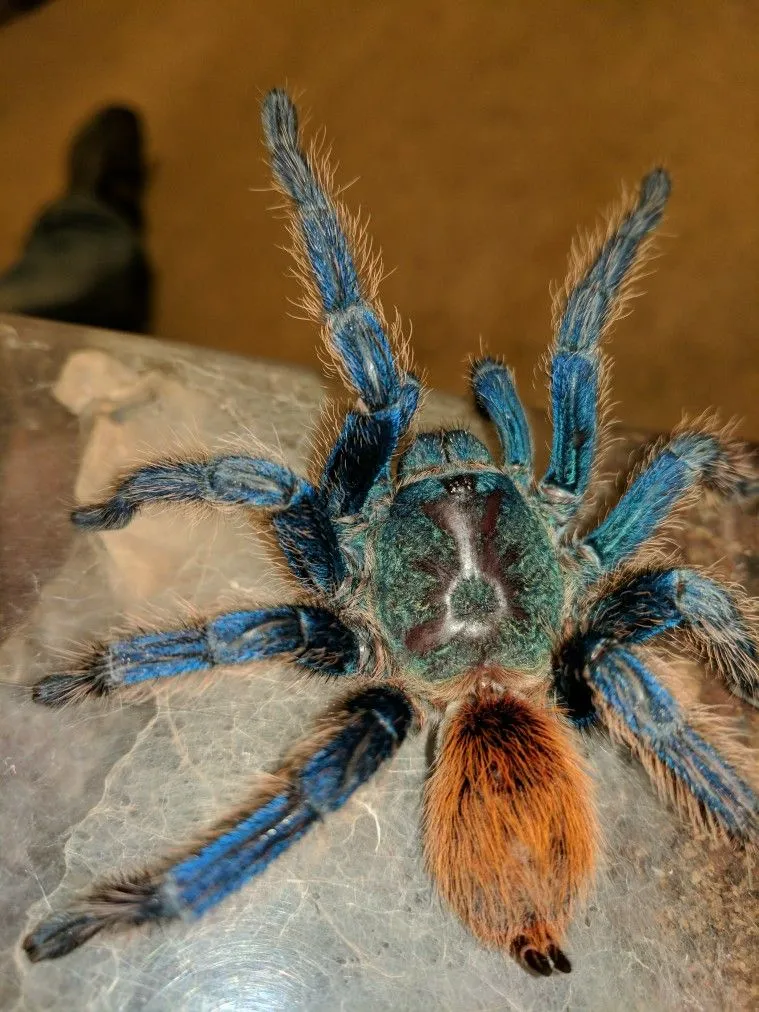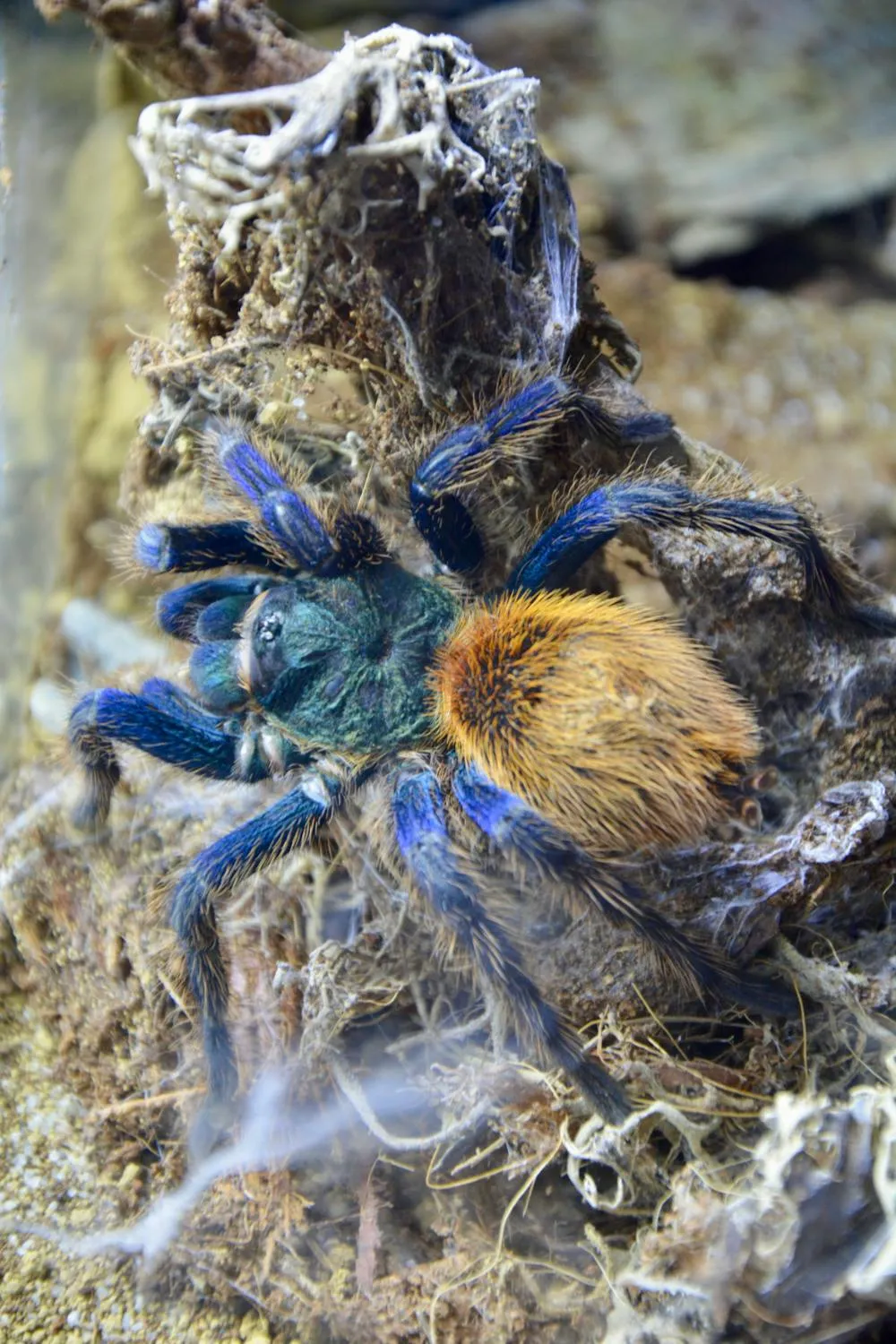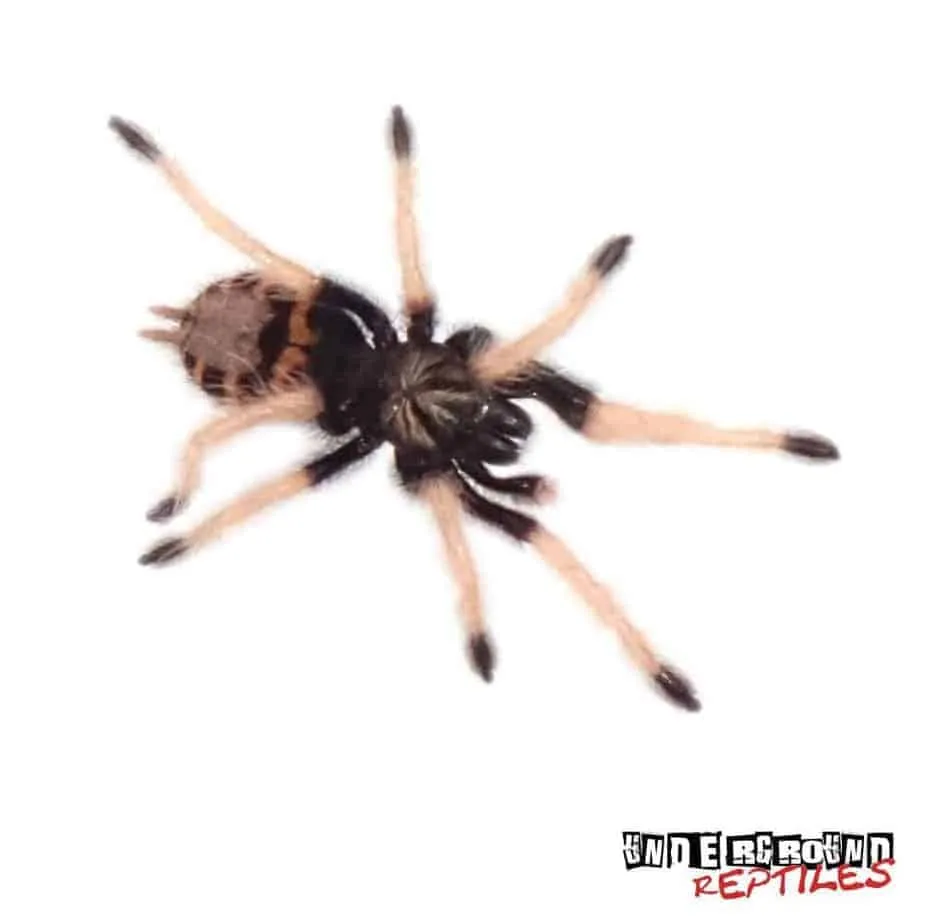Choosing the Right Blue Tarantula Tank Size
The first step in setting up a blue tarantula tank is selecting the appropriate size. The size of the enclosure directly impacts the tarantula’s well-being and ability to thrive. A tank that is too small can restrict movement and lead to stress, while a tank that is too large can make it difficult for the tarantula to find its food. As a general rule, the tank should be at least three times the tarantula’s leg span in width and length. This allows ample space for the tarantula to move around, molt, and hunt. Vertical space is also important, especially for arboreal species, as they will appreciate having room to climb and web. Consider the adult size of your blue tarantula species when choosing the tank size, as some species can grow quite large. Always prioritize the tarantula’s comfort and ability to live a natural life when deciding on tank dimensions. Remember that a properly sized tank is the foundation of a healthy and happy blue tarantula.
Selecting the Ideal Tank Material
The material of the blue tarantula tank is another essential factor to consider. The two most common materials are glass and acrylic, each with its own set of advantages and disadvantages. Glass tanks are generally more affordable and offer excellent visibility. They are also resistant to scratches and easy to clean. However, glass tanks can be heavier and may not retain heat as efficiently as acrylic. Acrylic tanks, on the other hand, are lightweight, more durable, and provide better insulation. They also offer superior clarity, allowing for unobstructed viewing of your tarantula. However, acrylic tanks are more prone to scratching and can be more expensive. Regardless of the material, ensure that the tank has a secure lid to prevent escapes, as blue tarantulas are skilled climbers and can squeeze through small openings. Ventilation is also crucial, so choose a tank with adequate airflow to prevent the build-up of humidity and the growth of mold.
Glass vs Acrylic Tanks

When deciding between glass and acrylic tanks for your blue tarantula, consider the long-term benefits. Glass tanks are a more budget-friendly option and are readily available. They are also excellent at showing off your tarantula. Acrylic tanks, while more expensive initially, can last longer due to their durability. They are also lighter and easier to move around if you need to rearrange your setup. The best choice depends on your budget, aesthetic preferences, and the specific needs of your tarantula. Evaluate which material offers the best balance of functionality, durability, and ease of maintenance for you. No matter the material, make sure to place the tank in a stable location away from direct sunlight and drafts. The stability of the tank is critical for the safety of your tarantula.
Optimizing the Tank Environment Humidity
Maintaining the correct humidity levels is critical for the health and well-being of your blue tarantula. Blue tarantulas thrive in a moderately humid environment. The humidity level should be around 60-75%, depending on the species. Too much humidity can lead to mold growth and respiratory issues, while too little can cause molting problems and dehydration. To achieve the proper humidity, you can mist the tank with a spray bottle filled with dechlorinated water. The frequency of misting will depend on your tank’s ventilation and the ambient humidity in your home. A good rule of thumb is to mist the tank once or twice a week, or as needed to maintain the correct humidity levels. You can also increase humidity by providing a water dish, which will release moisture into the air through evaporation. Carefully monitor the humidity levels and adjust your misting and watering schedule accordingly.
Monitoring Humidity Levels
Regularly monitoring the humidity levels in your blue tarantula’s tank is essential. The easiest way to do this is to use a hygrometer, which measures the relative humidity in the air. Hygrometers come in both analog and digital versions. Digital hygrometers are often more accurate and easier to read. Place the hygrometer in the tank in a location where you can easily view it. This will allow you to monitor the humidity levels daily and make adjustments as needed. Be sure to also check the substrate, which should be slightly moist but not waterlogged. If the substrate is too dry, increase the frequency of misting. If it is too wet, improve ventilation to allow it to dry out. Consistent monitoring and adjustments are the keys to maintaining the perfect humidity level for your blue tarantula.
Setting Up the Substrate for Your Blue Tarantula

The substrate is the bedding material that lines the bottom of your blue tarantula’s tank. It serves multiple purposes, including providing a comfortable surface for the tarantula to walk on, helping to maintain humidity, and offering a place for the tarantula to burrow if it is a terrestrial species. The substrate should be deep enough to allow the tarantula to burrow if it is a burrowing species, and the substrate should be approximately 2-4 inches deep for most species. When selecting a substrate, choose one that is safe, non-toxic, and able to hold moisture. Avoid substrates that contain harmful chemicals or that can splinter and injure your tarantula. Provide a safe and comfortable substrate for your tarantula is important for their health and happiness.
Best Substrate Options
Several substrates are suitable for blue tarantulas. A popular choice is a mixture of coconut fiber (also known as coco coir) and peat moss. These materials hold moisture well, provide a natural look, and are relatively inexpensive. You can also use a mix of organic topsoil and sand, which offers good drainage and allows burrowing species to create tunnels. Avoid using substrates that are too dusty, as they can irritate the tarantula’s respiratory system. Substrate should be replaced or spot-cleaned regularly. Removing any visible waste will promote a clean and healthy environment for your blue tarantula. The ideal substrate provides the right balance of moisture retention, drainage, and burrowing capability, so take the time to select the perfect mix for your tarantula’s needs.
Creating a Comfortable Tank Temperature
Maintaining the correct temperature is crucial for the health and activity level of your blue tarantula. Most species thrive in temperatures ranging from 75-85°F (24-29°C). The specific temperature requirements may vary slightly depending on the species. Use a thermometer to monitor the tank temperature and ensure it remains within the desired range. To provide heat, you can use a heat mat or a ceramic heat emitter. A heat mat is placed under the tank and provides gentle, consistent heat. A ceramic heat emitter emits infrared heat, which is safe and effective. Avoid using heat lamps, as they can dry out the tank and potentially burn your tarantula. Place the heat source on one side of the tank to create a temperature gradient, allowing the tarantula to choose its preferred temperature. Never place a heat source directly inside the tank, which can cause burns.
Providing Proper Heating and Lighting

Lighting is less critical for blue tarantulas, as they are nocturnal creatures. However, providing a natural day-night cycle is still beneficial. You can use a low-wattage LED light to simulate daylight. Ensure the light does not generate excessive heat or stress the tarantula. Avoid using bright or direct sunlight, which can overheat the tank. Position the tank in a location that receives natural light but not direct sunlight. A timer can be used to control the lighting, providing a consistent day-night cycle. Regular cycles, a proper temperature gradient, and a good quality substrate will provide an excellent living environment for your blue tarantula, which will enable it to live a long and happy life.
Essential Tank Decorations and Hides
Providing decorations and hides in the tank is important for your blue tarantula’s well-being. Tarantulas are naturally shy creatures, and they need a safe place to retreat when they feel threatened or want to molt. A hide can be as simple as a piece of cork bark, a hollow log, or a commercially available tarantula hide. Place the hide in a corner of the tank, creating a secluded and secure area. Decorations such as artificial plants, branches, and rocks can also be added to provide enrichment and visual interest. Avoid sharp objects that could injure the tarantula. Arrange the decorations to provide climbing opportunities for arboreal species and hiding places for all tarantulas. These decorations will create a more natural and stimulating environment for your blue tarantula to live in.
Adding Plants for a Natural Habitat
Live or artificial plants can enhance the aesthetic appeal and functionality of your blue tarantula’s tank. Live plants can help maintain humidity and create a more natural habitat. Choose plants that are non-toxic and that can tolerate the tank’s humidity levels. Some suitable options include pothos, snake plants, and ferns. Artificial plants are a low-maintenance alternative and can provide a similar visual effect. When adding plants, ensure they do not take up too much space, leaving room for the tarantula to move around and hunt. Arrange the plants to create hiding places and climbing opportunities. Plants also enhance the aesthetic beauty of the tank and make it a more appealing environment for both the tarantula and its keeper. By thoughtfully incorporating decorations and plants, you can create a stimulating and enriching environment for your blue tarantula.
Feeding and Watering Your Blue Tarantula

Providing proper nutrition and hydration is critical for your blue tarantula’s health. Tarantulas are insectivores, and their diet should consist primarily of live insects. The size of the insects you feed your tarantula should be appropriate for its size. As a general rule, the insects should be no larger than the tarantula’s body. Common food items include crickets, mealworms, dubia roaches, and other commercially available insects. Feed your tarantula one or two appropriately sized insects every week or two, depending on the species and its feeding habits. Be sure to remove any uneaten insects from the tank, as they can stress the tarantula. Provide a shallow water dish with fresh, clean water at all times. The water dish should be small enough to prevent the tarantula from drowning. Remember, a well-fed and hydrated tarantula is a healthy and happy tarantula.
Choosing the Right Food
The diet of your blue tarantula should be varied and nutritious. The most popular food choices are crickets and roaches, but it is important to supplement them with other insects to provide a more balanced diet. Consider offering mealworms, superworms, or even small locusts as occasional treats. Before feeding insects to your tarantula, they should be gut-loaded. This means feeding the insects a nutritious diet for at least 24 hours before offering them to your tarantula. Gut-loading ensures that the insects are packed with vitamins and minerals, which will benefit your tarantula. You can also dust the insects with a calcium and vitamin supplement to further enhance their nutritional value. Choose appropriately sized prey, monitor your tarantula’s feeding habits, and adjust its diet as needed to ensure it is receiving proper nutrition.
Setting Up a Water Dish
Providing a constant supply of fresh water is crucial for the health of your blue tarantula. The water dish should be shallow enough to prevent the tarantula from drowning, but still accessible. Choose a small, stable dish that will not tip over easily. Ceramic dishes are a good option, as they are easy to clean and will not be easily disturbed. The water should be replaced daily, as it can become contaminated with substrate, debris, or insect waste. You can use tap water, but it is best to use dechlorinated water to remove any harmful chemicals. Regularly cleaning and maintaining the water dish ensures that your blue tarantula has a clean and safe source of hydration. By paying attention to your tarantula’s feeding and watering needs, you will be well on your way to creating the ideal tank setup.
